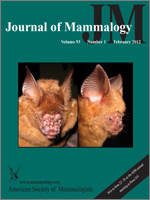Assessing the relative importance of environmental and anthropogenic influences on the distribution of wild populations is an important step in designing spatially explicit plans for their management and protection. We examined environmental variables correlated with the spatial distribution of eastern Pacific harbor seals (Phoca vitulina richardii), a marine mammal common to coastal waters, in a large, highly urbanized estuary. We assessed the relationship between prey abundance, depth, bottom relief, proximity to terrestrial haul-out sites and 3 potential sources of anthropogenic influence, and the in-water spatial distribution of seals. We identified locations of seals using satellite-linked telemetry, and used partial Mantel tests to assess which environmental variables were most strongly linked to seal foraging distribution, given spatial autocorrelation within variables. Mann–Whitney tests were used to compare environmental characteristics of locations of seals with a random distribution of locations. Because harbor seals are central-place foragers, we incorporated spatial distribution of seals relative to the central place into our analyses. High prey abundance and proximity to the haul-out site were strongly associated with the spatial distribution of seals. Harbor seals also tended to use deeper waters and areas of high bottom relief within the estuary. There was no consistent spatial relationship between the 3 anthropogenic factors and the distribution of seals, although seals tended to be found closer than expected to sites of high human activity. In highly impacted coastal areas where limited alternate suitable habitat exists, foraging seals may need to rely on disturbed (suboptimal) areas, and as a result may habituate to human presence in areas rich in food resources.
How to translate text using browser tools
1 February 2012
Foraging distribution of Pacific harbor seals (Phoca vitulina richardii) in a highly impacted estuary
Emma K. Grigg,
Sara G. Allen,
Deborah E. Craven-Green,
A. Peter Klimley,
Hal Markowitz,
Deborah L. Elliott-Fisk
ACCESS THE FULL ARTICLE

Journal of Mammalogy
Vol. 93 • No. 1
February 2012
Vol. 93 • No. 1
February 2012
central-place forager
disturbance
Geographic Information System
habitat use
Harbor Seal
Phoca vitulina
satellite telemetry




